PDF chapter test TRY NOW
"Extreme fear can neither fight nor fly" is a quote by Shakespeare that depicts the situation in the lesson 'His First Flight'. But the quote is not to belittle the emotion called fear but serves as a reminder that extreme fear can hinder one's growth. The lesson revolves around a young seagull who is scared to fly, as he has not been exposed to it yet. The lesson shows that fear can destroy us, but at the same time if triggered in a positive way, it can also make us.
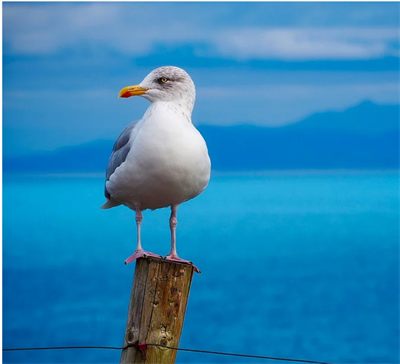
A little seagull
The lesson begins in the midst of the events that have already unfolded. It depicts a young seagull standing alone on the corner of a cliff. If a person jumps out of the cliff without any proper equipment like a parachute or rope, there is a chance to get hurt badly. The seagull is a little one and is very similar to a person who does not possess the gift of flying. Just because it is a bird, it does not start flying the minute it gets hatched. Birds lay eggs and hatch them in their nests. Once they hatch, the little ones grow up and learn to fly. But this process may not be as easier as it sounds. Just like a child learns to crawl, it is a long process. There is a chance that children might fall into this process. They initially crawl and then learn to stand up with support and then walk. Similarly, birds, when they feel ready to fly, they start flapping their wings and flying around. They initially do not fly for hours together as fledglings need time to get used to it. Birds have hollow bones that help them in flying.
The seagull feels bad as all its brothers and sisters have already flown away without any fear. The worst kind of fear arises when we see that every other person has moved ahead in life or has achieved the one thing that we have been struggling to do. That makes one feel left out. The seagull had not flown along with its siblings. It had tried its best as it ran from one end of the cliff to the corner and tried to flap its wings and fly. But once it saw that below the cliff it was an abyss of ocean, it was scared of the consequences of falling down. The sea stretched below it, and it looked like it was a long way, miles down. The seagull was scared of the possibility of hurting itself and ran back quickly to the hole in the other edge of the ledge, where it usually slept at night. Often times, we do not act on certain things, not because of the intensity or the difficulty of the task, rather it is because of focus on the outcome or the consequences. The little seagull got scared by looking at the possibility of what might happen if he did not fly high and dropped down.

End of a cliff
The young seagull is scared to jump from the ledge and start exploring the world. Its brother and even its sister, who was younger than it, had taken the courage to jump and fly away. Its little sister had very shorter wings compared to the seagull but still ran to the brink of the ledge, flapped its wings and flew away. The reason why the birds are made to run and jump from the cliff is that when one is in the process of running, one does not think. It is done based on instinct. But the seagull had the outcomes and possibility of falling run at the back of its mind and therefore was not able to take the risk. It also shows that different people fear different things, and age does not impact it. Sometimes we are scared of things but feel guilty and desperate about not taking the plunge. It is this guilt that is even more tormenting than not taking action.
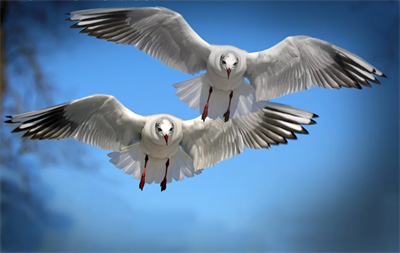
The seagull's siblings fly
The seagull, who is already feeling bad for not keeping up with its siblings, is now scolded and yelled at by its parents. Parents often have expectations of their kids and want them to perform well in life. Sometimes they exert tough love. When one believes that they are on the verge of being left out and that they are on their own, there is a huge chance that they put in their maximum efforts to come out of it and resonate with a group. Similarly, the seagull's parents threaten that they would leave it and make it starve on the ledge and will not help. Now that it is left to fend for itself, the parents think that it is necessary to show some tough love. But it was not willing to give in, even if it meant earning the wrath of the parents. A day had passed with 24 hours passing by, and no one had still come near the seagull.
The little seagull feels left out from his family as he is the only one who has not flown in the entire family. Often times, disappointing our parents is the most hurtful thing. It makes us feel like a failure, especially if we have siblings who have excelled. The seagull stands on the ledge, watching its parents flying around with its siblings and having fun. The parents were guiding the siblings and perfecting their flight, giving insights. Seagulls consume fish as their main source of food, so the parents taught them how to swoop down and dive for fish. The little seagull also sees one of the brothers catching a herring, which are fish found in coastal areas. This being an achievement indeed, receives praises from the parents. They circled around the brother, cackling, indicating their pride. His entire family made the little seagull feel insecure by laughing at him and excluding them from their party, calling him a coward for not flying.
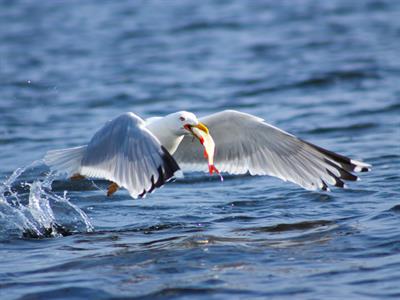
Seagull catching fish
The little seagull was very guilty about disappointing its parents. It also felt bad that it was not able to fly like its siblings and was the only one to have not flown in the family. It felt left out completely. A day had passed, and it still stayed at the hole in the end of the ledge. It did not come out due to embarrassment. But the sun was shining brightly, the next morning, and it was blazing on top of the ledge that was facing the south side. When one does not eat or is starving, they notice minute sensations, and the littlest of the things can irritate them. The seagull had not eaten anything the day before, owing to the fact that it had disappointed its parents and they refused to feed him until he flies. The heat therefore gets intense and it feels the sun on the body.
The seagull only had a small mackerel tailpiece, which is a fish found on the coastal areas. The fish was dried because it was not caught fresh from the sea. It had to adjust with the dried already existing piece of fish as it was not able to fly and catch its own food. There was no scrap of food left for it to eat, and there was nobody to help with catching fish. It searched all over the ledge for some food. He searched the dirt and rough patches of the cliff. At last, it desperately had to search in its own nest where its brothers and sister, along with the seagull, had been hatched. The nest is only a temporary home for the birds as they hatch and fly in their own directions, fending for themselves. But the seagull is faced with a situation where it had to gnaw at the broken pieces of the egg that it came out from in search of food. It says that it felt like eating a part of the self, as the egg was the protective cover that kept the bird safe until it was hatched.
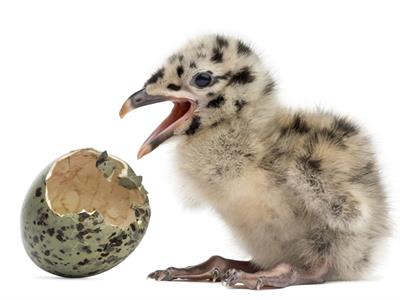
Seagull beside the hatched egg
Finding no way to get food, the seagull had to walk to and fro the ledge, thinking of a solution. It had so far been cared for by its parents and it felt new to be by itself. Like every other child, the seagull turns towards its parents for food and comfort. It strode with its long grey feet delicately and cautiously as its mind is occupied in thinking of how to cross to the other side of the ledge to its parents. The ledge had a deep crack, and it had to fly to reach. It was on the very steep side of the ledge that if tried walking, it would fall down into the sea. Even if it were to walk along the northern side of the cliff, which was nothing but empty space. It had nothing to walk on like a bridge. Only a housefly could travel across such small gaps. Below and above the cliff were very deep, and it was scared of falling.
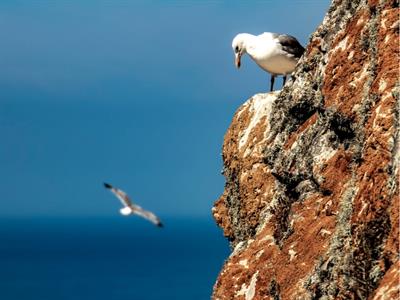
Seagull looking down the cliff
The seagull was desperate to get some food but was not ready to fly and reach the family at the other end. It knew that it had to gather attention from the family members in order to get food. Any family would give up on the toughness if they sense that one of them is in trouble or on the verge of getting themselves into a difficult situation. So the seagull slowly walked to the edge of the cliff and made sure that its family could see what it was up to. It folded one of its legs and hid it under the wings so as to gain balance in standing. It then made it appear that it was falling asleep standing on edge and that there was a chance of falling. But unfortunately, its family did not take any notice of the seagull.
Its two brothers and sisters had already proven their skill of flying and now take rest dozing in the plateau. They did not take any notice of their sibling, who had not even started with it. They were sleeping with their heads stuck to their neck, showing that they were lethargic and resting well. The seagull's father was preening its feathers, such that it was cleaning itself with the beak. Birds generally preen when they have nothing else to do after having food and are in their resting phase. But the mother was looking at the seagull from a distance. She was standing on top of the hump of a plateau and was observing her child, with her white breast thrust forward, showing that she was holding herself up pretty well. She was cleaning and pecking at a piece of fish with her beak and scraped her break every time into nearby rock to give it more intensity to tear at the fish. The seagull, who was so hungry, was maddened at the sight of the food right in front of it and was not able to reach it. It wanted to desperately tear at the fish and eat and sharpen its beak every time in rock, just like the mother gull.
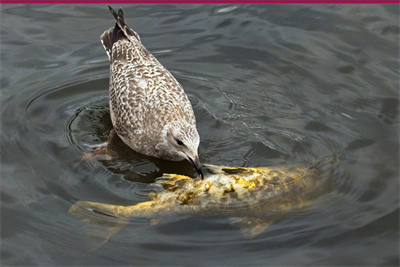
Seagull pecking at scrap of fish
The seagull tried to draw attention by uttering a cackle. The mother bird responded and cackled back, leading him to think that she had sympathised with it. It took the opportunity to communicate with the mother and cried ga ga ga, which refers to the sound a seagull would make. It cried to beg and ask the mother to bring some food as it was starving. But the mother bird retained the composure and cried back ‘Gawl-ool-ah,’in a mocking way. But the seagull was very persistent and kept on crying for food to trigger her motherly instincts. After a while, the mother moved her place, and this overjoyed the seagull as this meant she had taken a soft corner and was about to bring food. The mother bird had taken a small piece of fish and was flying towards the seagull, which made it utter a joyful scream. It leaned out eagerly and was restless for food, tapping the rock with the feet to inch closer. But the mother bird, as soon as she reached the hedge, her wings did not flutter or legs did not move. She just stood there holding the fish, almost within reach of the seagull, but at the same time a little away.
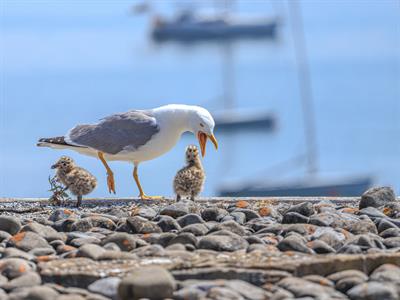
Mother gull with chicks
The seagull's mother had come near it, with a piece of fish in her mouth to tempt it. Initially, it was overjoyed to see that after a day of starvation, the mother had finally come down with food. But when it realised that the food was only at its mouth's reach and not put the right front of it like always, it became angry. But it was very hungry, and people become maddened when they are hungry. The seagull was so lured by the food that it jumped to catch hold of the fish. Generally, one tends to go down and put any effort if that is the only and last resort. They do not use logic and plan, rather would delve into it quickly. The seagull was only focussed on the food that is, for a moment, forgot the circumstances and fear.
The mother bird purposefully used the fish as the bait, and therefore when the seagull tries to reach the food, it falls outwards and downwards into the space. Exactly when it reached out, the mother bird had swooped upwards, making the seagull fall and could hear the swish of the wings as it was falling. By the time the seagull realised what was happening, a monstrous terror shook it, and for a moment, it could not hear its heartbeat, meaning that fear overtook its entire body. As it was falling from an altitude, the wind brushed fiercely into its breast feathers and felt the tip of the wings cutting through because of the intensity of the wind. But it soon realised that it was flying in the process. It was soaring upwards and downwards.
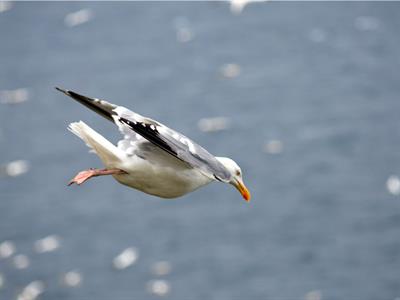
Little seagull in flight
Once it had experienced the feeling of being in the air, courage picked up, and it uttered a joyous scream and started flapping its wings. Most of the time, it is only the fear of beginning something, and once we get to delve into the experience, we may realise how trivial our fears were and start enjoying the moment. The mother bird just gave a push and motivation to the seagull, and it overcame its fear. He raised his body up in the force of the wind and flew happily. Its brothers and sisters started flying around screaming ga ga ga to each other. They started flying and screaming as a family. Flying is the seagull's natural trait, and it soon becomes inherent that it almost forgot that it was initially reluctant to fly.
The little bird being a newbie to flying had become tired due to the exercise. One cannot overdo any exercise as it can drain energy. Being a seagull, it landed on the green sea and immersed feet in it to rest. Its parents and siblings landed on the green sea and called out from either side. When it entered the surface to rest, it was not able to even float properly as it was tired and hungry since it had not eaten anything from morning. It had become the hero in one day as it rested its belly on the surface and the family fed scraps of dogfish to it, cheering and screaming. The little seagull had finally made its first flight.
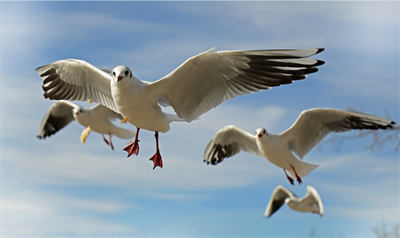
The seagull flew with the family
